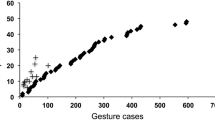Abstract
I made systematic observations of three infant chimpanzees aged 2–4 years, who participated in a series of diagnostic tests of combinatory manipulation. The tasks were stacking blocks, seriating nesting cups, and inserting an object into the corresponding hole in a plate or a box. These tasks were originally devised for developmental diagnosis of human infants. The chimpanzee infants displayed combinatory manipulation comparable to that of 1-year-old human infants. Common motor characteristics were observed across the tasks, namely “repetition” of actions, “adjustment” of actions, “reversal” of actions, and “shifts” of attention. Humans and chimpanzees share these actions when manipulating multiple objects to complete a task. Repetition, adjustment, and reversal of actions and shifts of attention underlie higher levels of cognition common to both species.
Similar content being viewed by others
Author information
Authors and Affiliations
Additional information
Accepted after revision: 5 May 2001
Electronic Publication
Rights and permissions
About this article
Cite this article
Takeshita, H. Development of combinatory manipulation in chimpanzee infants (Pan troglodytes). Anim.Cogn. 4, 335–345 (2001). https://doi.org/10.1007/s100710100089
Received:
Published:
Issue Date:
DOI: https://doi.org/10.1007/s100710100089




